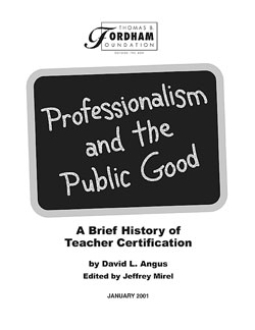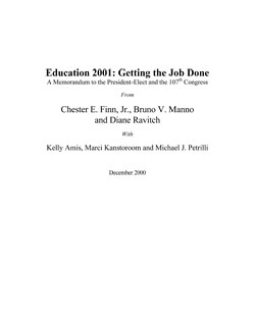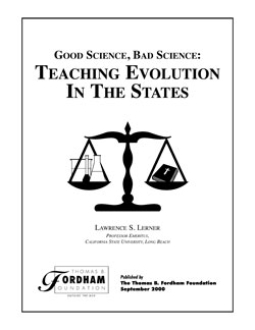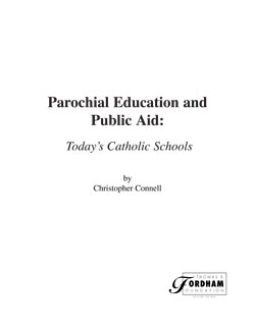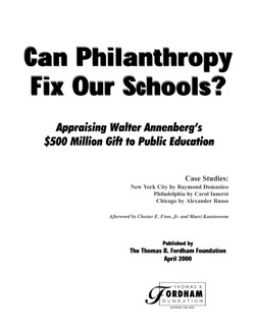The National Assessment of Educational Progress (NAEP) recently released the results of the 4th grade reading assessment conducted in 2000. (By NAEP standards, alas, this is speedy: data available just a year after the test was given!) The news is not good: average scores were essentially flat across the 1990's. That would be okay if they were flat at a high level but they're flat at a woefully low level. Almost 2 fourth graders in 5 are "below basic" and only one in three is "proficient" (or better). When the data are disaggregated, the results become even more alarming: among black and Hispanic youngsters, roughly three-fifths don't reach "basic" and fewer than one in six is proficient. (This is also true for low-income children.) Though black youngsters fared slightly better in 2000 than in earlier years, the gains are meager compared to the gap that remains. The Nation's Report Card: Fourth-Grade Reading 2000, April 2001. The publication number is NCES 2001-499. Copies can be obtained by phoning (877) 433-7827, ordered on-line at www.ed.gov/pubs/edpubs.html or downloaded from http://nces.ed.gov/nationsreportcard.
by Craig Jerald, the Education Trust (published by the Business Roundtable)
On the campaign trail, Governor George W. Bush touted the "Texas education miracle"--in which the Lone Star State's poor and minority children made huge gains in test scores--as evidence that academic standards and accountability could generate significant improvement in student achievement. Now that Mr. Bush is in the White House, supporters and critics alike have taken a closer look at the Texas record.
Published last month by The Business Roundtable, this latest report describes what's known about the effects over the past decade of Texas efforts to raise academic standards, measure student performance, and increase accountability via consequences for results. Author Craig D. Jerald, senior policy analyst at The Education Trust, explains that, among the 50 states, Texas has made one of the most concerted and long-running attempts to raise student achievement. The Texas strategy is successful, Jerald argues, because it is balanced, blending an unusually strong measure of both optimism--setting high standards for all students--and pragmatism, i.e. setting reachable goals that are raised incrementally. Critics often claim that Texas's tough policies have led to higher dropout rates, a narrowed curriculum, and inordinate focus on "low-level" skills measured by the state assessment exam. Jerald finds little evidence to support these claims. Rather, he says, high school graduation rates have actually gone up, there has been no discernable negative impact on the curriculum, and Texas students have proven their ability to master higher-order skills by boosting their scores on NAEP, a more rigorous exam that is administered to a representative sampling of students nationwide.
For all its accomplishments, however, Texas is not yet out of the water. The report concludes that, while real results have been achieved, the state has a long way to go to ensure that none of its children are left behind. To learn more about Texas's lengthy experiment in standards-based reform, check out the report online at www.brtable.org.
Like many skillful leaders whose successes throw them before the public's eye, Wendy Kopp has her share of detractors, including some within the ranks of the unique teaching corps she created. She has been criticized for never having taught herself and for placing inexperienced, uncredentialed teachers in classrooms all over the country (even though most principals adore their Teach for America teachers and are begging for more). And despite the fact that she has nearly single-handedly funneled more than 5,000 high-achieving college graduates into some of the most troubled schools in America—and consequently created a group of devoted advocates for equity in education (the author included)—Ms. Kopp nonetheless gets harangued for her reluctance to add herself to the already-crowded arena of education talking heads opining on innumerable policy issues.
Thus, her new book, which is heavy on the Teach for America story but light on policy talk and personal opinions about education reform, has been criticized for not taking a strong stand on the day's hot-button issues. But this book is vintage Kopp and provides the reader with an interesting glimpse into this reticent but supercharged leader.
Ms. Kopp conceived of Teach for America during her senior year at Princeton and simply set out to make it happen. Nothing, it seems, could distract her from this mission, although there were discouraging moments. She tells of staff revolts, disgruntled corps members, and the constant state of financial crisis that kept her scurrying from one prospective funder to another just to meet payroll. Through it all, she stayed focused on achieving her mission—a sustainable organization that would continuously feed new, capable teachers into failing schools—without bending toward what others might have wanted her to be (a warm and fuzzy people person, an outspoken critic of the public education system, a policy wonk using her position to try and sway public opinion, etc.).
One Day, All Children is not a Kozol-esque volume of affecting stories about children and the teachers that love them. It is a saga of young leadership and effective social entrepreneurialism. Perhaps it will inspire more individuals concerned with the fate of our education system to put these skills to use for the direct benefit of disadvantaged students.
One Day, All Children is published by PublicAffairs at the Perseus Books Group, which can be reached at 617-252-5298. It is also available at both http://www.amazon.com and www.borders.com
The Education Trust's newsletter, Thinking K-16, is usually worth a look. The Winter 2001 issue is especially fine, being devoted almost entirely to a careful but exceptionally lucid discussion of U.S. high school results during the period since the Nation at Risk report of 1983 and the declaration of national education goals in 1989. How have we fared? ask authors Kati Haycock and Sandra Huang. Their one sentence summary: "In general, the data suggest an object at rest in a world that is rapidly rushing by." Data from an array of sources are here compiled, analyzed and presented in exceptionally concise and clear ways. You'll want this one. Phone (202) 293-2605 or surf to www.edtrust.org.
Thirty percent of students surveyed in grades 6 through 10 have been involved in either bullying or being bullied themselves, according to a study released by the National Institute of Child Health and Human Development (NICHD) earlier this month. Widening concern over bullying in schools has its roots in school shootings, many of which were conducted by students who had been the victims of long-term bullying, notes Ben Soskis in this week's New Republic, but the anti-bullying movement may be overreacting. When does behaving childishly (or like a teen-ager) become bullying? The NICHD study itself includes in its definition of bullying all sorts of things that ordinary kids do, such as spreading rumors and shunning other children.
The same inability to distinguish between childish behavior and the homicidal tendencies has fed a growing movement among phys ed teachers to ban dodge ball, based on evidence from a recent symposium about the game that appears in the Journal of Physical Education, Recreation and Dance, a movement that has been mocked by liberals and conservatives alike in the past week. Banned in Austin (Texas), dodge ball has been relegated to the "physical education hall of shame," joining musical chairs and duck, duck, goose, which fell into disrepute years ago because they may give rise to self-esteem problems, according to Neil Seeman, writing in the National Review Online.
The impulse behind these attempts to protect the young from every form of angst and social pain also lies behind zero tolerance policies aimed at reducing school violence. That's the kind of policy responsible for suspending a 5-year old for carrying a plastic axe as part of his Halloween firefighter costume. In this week's National Review, John Derbyshire argues that such policies are flawed reactions to bleeding-heart judges and softheaded administrators who cannot be trusted to do the right thing, and to the collapse of authority in general.
More at: "Bully Pulpit," by Benjamin Soskis, The New Republic, May 14, 2001; "The Painful Playground," by Marjorie Williams, Washington Post, May 9, 2001; "Dodge This," by Neil Seeman, National Review Online; "The Problem with 'Zero'," by John Derbyshire, National Review, May 28, 2001 (not available online).
Why does our system of teacher certification emphasize training in pedagogy rather than subject-matter knowledge? The answer can be found in this report, which traces the emergence of state control over teacher certification. The focus is on efforts by the teacher education establishment to gain monopoly control over the licensing of teachers.
President Bush campaigned on a strong education-reform platform, promising the American people that for the first time in a long time, commonsense?not special interest groups?would dictate federal education policy. Just before he entered the Oval Office, we handed him a briefing book on steps he could take to help transform the K-12 education system. In this "Memorandum to the President-Elect and the 107th Congress," we explained how the federal government has wasted billions of dollars on ineffective programs and offered suggestions for making continued federal funding matter.
More than one-third of the states get low grades for the standards they have developed for teaching evolution, according to this new report. This report is the first comprehensive analysis of how each state handles evolution in its science standards for the public schools.
How much government aid do parochial schools and their students actually receive? Connell finds that public aid flows to church-affiliated schools through many channels, though amounts vary greatly from state to state. This report is especially timely in light of the Supreme Court's important decision upholding government aid to religious schools.
According to this new study, Ambassador Annenberg's gift has left only small footprints on the urban school systems it set out to reform. Good intentions and a generous checkbook were not enough to transform troubled urban schools. This report includes case studies of New York (by Raymond Domanico), Chicago (by Alexander Russo) and Philadelphia (by Carol Innerst) and an afterword by Chester E.Finn Jr. and Marci Kanstoroom.
